Clinical Center News
CC, NIAID Vaccine Research Center launch mobile clinic to take research, education messages to the streets
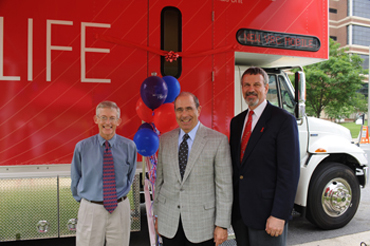 |
Standing in front of the mobile clinic are (from left): Dr. H. Clifford Lane, deputy director for clinical research and special projects at NIAID; Dr. John I. Gallin, director of the CC; and Dr. Barney Graham, a senior investigator and chief of the clinical trials core and the viral pathogenesis laboratory.
|
by Jenny Haliski
If the presence of a large purple, red, white, and blue truck parked near Building 40 at the intersection of Convent and South Drives on June 6 didn’t indicate that something was happening, the announcements over the bullhorn did. Turns out, the bullhorn was an appropriate symbol for the event—the launch of a mobile clinic by NIAID’s Vaccine Research Center (VRC) and the Clinical Center (CC).
Dr. Barney Graham, a senior investigator and chief of the clinical trials core and the viral pathogenesis laboratory, explained that's how it's done in Tanzania. There, health educators attract thousands to HIV/AIDS workshops by driving down the street and calling out with a bullhorn. The mobile clinic will serve a similar purpose much closer to NIH—facilitating community involvement and clinical research education in the Washington, D.C. area.
The mobile unit is an extension of the VRC’s vaccine clinic within the CC, according to Graham. Currently located on 12W in Building 10, the permanent clinic will eventually move to 5NES. Meanwhile, the clinic team will use the mobile unit to raise awareness about HIV vaccines, increase their capacity for enrolling healthy adults into outpatient studies, and make participation in clinical trials more convenient. “These volunteers are typically employed, busy people and we hope the mobile clinic will make enrollment in trials more convenient, and at the same time extend the visibility of NIH and the Clinical Center,” he said.
 |
An interior view of the patient care area inside the mobile clinic.
|
VRC staff plan to take the clinic anywhere they are currently involved in HIV/AIDS and other infectious disease outreach, including neighborhoods in Baltimore, Frederick, and the District. They will continue to work with HIV/AIDS organizations, city health departments, churches, college campuses, and outreach event organizers, but in an expanded capacity. The van’s first community appearance was June 15 at the 33rd annual Capital Pride Festival, the fourth largest lesbian, gay, bisexual, and transgender celebration in the U.S. with more than 200,000 attendees and more than 200 community organizations, local businesses, and corporations participating.
In his welcoming remarks, CC Director Dr. John I. Gallin noted the recent attention to mobile health facilities in providing care to rural and underserved areas within the U.S. and abroad. “This is an exciting experiment in how to reach out to new volunteers. We hope it will bring more participation to all clinical research activities, as well as attention to NIH, NIAID, and the Clinical Center,” Gallin said.
In his remarks, Dr. H. Clifford Lane, deputy director for clinical research and special projects at NIAID, outlined the history of the VRC, which opened in 2000 to spearhead vaccine research from basic to applied science. The VRC has developed and implemented 20 protocols, of which 10 are complete, he said. The VRC’s work has included not only HIV/AIDS, but also established and emerging viral infections such as Ebola, Marburg, H5 influenza, West Nile, severe acute respiratory syndrome (SARS), and smallpox.
“The VRC is a genuine national asset that contributes to the health of the nation and the world,” Lane said. “It’s wonderful to see this new outreach to the D.C.-area, which is one of the places in the U.S. that is hardest hit by HIV. There’s such a great need for prevention, and this mobile clinic will reach out to the community outside the NIH gate to bring in new volunteers.”
For more information about the VRC’s work or to participate in a vaccine trial, go to http://vrc.nih.gov/ or contact vaccines@nih.gov or 1-866-833-LIFE.
Back to Top
CC director gives 2008 Decker Lecture
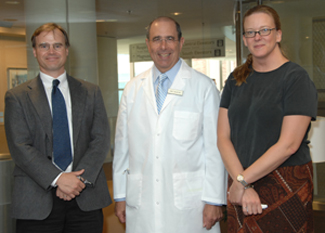 |
CC director Dr. John I. Gallin (center) with John Laws Decker's children, David Decker and Dr. Megan Malaro, at the reception sponsored by the Foundation for NIH after Gallin delivered the 2008 Decker Memorial Lecture on June 11.
|
The fifth in a series honoring NIH’s leaders in clinical teaching, the 2008 John Laws Decker Memorial Lecture on June 11 highlighted the accomplishments and research of Clinical Center Director Dr. John I. Gallin.
Named the NIH Fellows Committee’s 2007 Distinguished Clinical Teacher—the highest honor bestowed collectively on an NIH senior clinician, staff clinician, or tenure/tenure-track clinical investigator by the NIH Clinical Fellows—Gallin was invited to deliver the 2008 address.
Gallin's area of clinical expertise is the role of phagocytes, the body’s scavenger cells in host defense, play in chronic granulomatous disease (CGD). His laboratory has described the genetic basis for several forms of this disease and the use of interferon-gamma to reduce life-threatening bacterial infections in CGD and intraconazole to prevent fungal infections.
In his lecture, "Solving the Inflammation Puzzle One Patient at a Time," Gallin described how working with patients with rare disorders of neutrophils, the first type of phagocytes to arrive at a site of infection, have informed the field of inflammation in medicine.
|
Previous NIH Distinguished Clinical Teachers Awardees
|
- 2006 Dr. Elaine Jaffe (NCI)
- 2005 Dr. Lynnette Neiman (NICHD)
- 2004 Dr. David Goldstein (NINDS)
- 2003 Dr. Michael Bishop (NCI)
- 2002 Dr. Steven M. Holland (NIAID)
- 2001 Dr. Thomas J. Walsh (NCI)
- 2000 Dr. Crystal Mackall (NCI)
- 1999 Dr. Susan Leitman (CC)
- 1998 Dr. Dimitrios Boumpas (NIAMS)
- 1997 Dr. John Doppman (CC)
- 1996 Dr. James Balow (NIDDK)
- 1995 Dr. Maria Turner (NCI)
- 1994 Dr. John Bennett (NIAID)
- 1993 Dr. Henry Masur (CC)
- 1992 Dr. David Rubinow (NIMH)
- 1991 Dr. Fernando Cassorla (NICHD)
- 1990 Dr. John Klippel (NIAMS)
- 1989 Dr. James Shelhamer (CC)
- 1988 Dr. Anthony Fauci (NIAID)
- 1987 Dr. Alan Baker (NCI)
- 1986 Dr. Joseph Parrillo (CC)
- 1985 Dr. Lynn Loriaux (NICHD)
|
John Laws Decker began his career at NIH in 1965 as chief of the Arthritis and Rheumatism Branch, which is now NIAMS. He was director of the NIH Clinical Center from 1983 to 1990 and was named scientist emeritus following his retirement.
The 2008 Distinguished Clinical Teacher Awardee will be announced by the members of the NIH Fellow’s Committee at the CC’s Grand Rounds this fall and will be the invited lecturer at the John Laws Decker Memorial Lecture, sponsored by the CC and the Foundation for NIH, as part of the Great Teachers series of Grand Rounds in June 2009.
Back to Top
Transfusion Medicine laboratory dedicated to Charley Carter
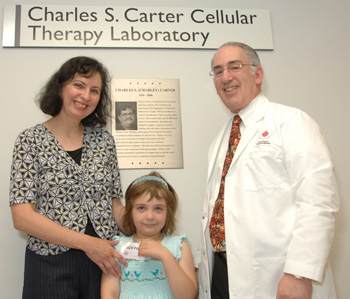 |
(from left): Laura Carter, Charley’s widow; Kate Carter, his daughter, and Department of Transfusion Medicine Chief Dr. Harvey Klein at the unveiling of the plaque dedicating the laboratory.
|
by Jenny Haliski
The Clinical Center’s Department of Transfusion Medicine (DTM) on June 18 dedicated the Charles S. Carter Cellular Therapy Laboratory within their Cell Processing Section (CPS).
Carter, who died in 2006, co-founded the cell processing laboratory and worked as a biologist, technologist, and supervisor in DTM for 24 years. The words engraved on his plaque describe Carter as “a wizard in the laboratory with an uncanny ability to grow cells in culture and a special affinity for medical instrumentation. His career was marked by energetic, innovative practical thinking,” as well as devotion to CC patients.
Only a handful of NIH laboratories or conference rooms are dedicated to individuals, according to DTM Chief Dr. Harvey Klein. Carter’s lab will join those notable exceptions, such as spaces dedicated to John Doppman, the chief of the CC diagnostic radiology department for 26 years, and Shelly Wolfe, former scientific director at NIAID. “A lab is more than just the walls, benches, and equipment within it. A lab is also the people who work there and their spirit,” said Klein. “Even those working in this lab today who never knew Charley are imbued with his spirit of creativity.”
In a 2006 tribute to Carter published in Cytotherapy, former DTM section head Dr. Elizabeth Read, who worked with Carter to develop methods for radiolabeling cells for in vivo cell trafficking studies, described how his career “was inextricably linked with the development of modern cellular engineering.” His career at NIH started as a summer volunteer in what is now the National Institute of Dental and Craniofacial Research.
He was hired as a technician in Dr. Joost Oppenheim’s lab, where he spent three years learning basic research. “The experience nurtured his passion for immunology and cell biology, and gave him a mature understanding of scientific investigation that imbued his future work,” Read noted. DTM hired him as a lab technician in 1982. According to Read, Carter was “recognized early on as one of the most skilled and innovative developmental technologists in our field” and would develop new procedures rather than rely on those previously used by a colleague.
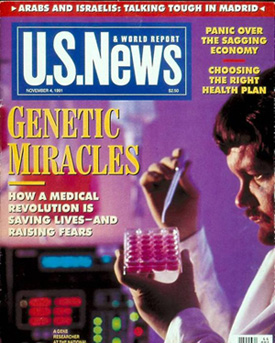 |
A November 1991 U.S. News and World Report cover of Carter standing in the lab pipetting cells. He was a key figure in a small team of scientists who prepared the first gene-corrected cells to treat a child with severe combined immunodeficiency syndrome.
|
Carter had a special genius for devising novel methods for preparing cellular therapies for clinical trials. He was a key figure in a small team of scientists who prepared the first gene-corrected cells to treat a child with severe combined immunodeficiency syndrome. Media coverage of the event included a November 1991 U.S. News and World Report cover of him standing in the lab pipetting cells.
His work was critical to the progress of numerous other intramural cell therapy programs, such as gene marking and gene therapy trials with investigators from several ICs. That same decade, Carter worked with NCI and NHLBI to develop new procedures for depletion of T cells from allogeneic bone marrow and peripheral blood stem cells to prevent graft versus host disease.
Other NIH cell therapy programs, many of which are still ongoing, that Carter’s work benefited include dendritic cell tumor vaccines for cancer immunotherapy, iron labeling of cells for diagnostic imaging, and culture-expansion of natural killer cells. Current CPS Chief Dr. David Stroncek said that he and his staff hope to “keep up Charley’s good work as we move forward in the laboratory.”
In his lifetime, Carter authored or co-authored more than 75 publications on investigative methods for cell collection, ex vivo processing and preservation, and characterization and testing of cell therapy products. He received both the Clinical Center Director’s Award and the NIH Director’s Award.
Carter’s mentoring and training of a generation of scientists from around the world in good laboratory practice as applied to research biologics inspired an award of its own. DTM medical technologist Jean Gildner presented the first CPS Technologist of the Year award to Peter Chen. Dedicated to Carter’s memory, the awardee is selected by their peers for their qualities in leadership, mentorship, and “Charley-ship”—which they defined as the willingness to smile, get to know others, and remember even in the worst moments the importance of the work at hand. According to Gildner, it was in Carter’s capacity as a supervisor that he influenced his colleagues the most. Klein also shared emails and phone calls he’d received to mark the occasion from Carter’s former colleagues, fellows, and friends around the globe—one coming from as far away as Norway.
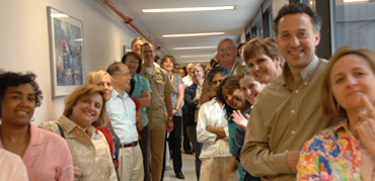 |
Carter’s colleagues and friends from the CC and other ICs within the intramural program who collaborated with him, as well as staff from the lab who never knew him and many who have since retired or moved on to other places, lined the hallways around the lab to be present at the dedication and reception.
|
In the words of Jo Lynn Procter, supervisor of operations for the section, it was “a special day to be with those who knew, worked with, and loved Charley.” Well-wishers stretched down the long hallway and around the corners near the laboratory, which was built in an area that used to be part of the roof of the old building before the need for such a lab existed at NIH.
Several members of the Carter family attended the dedication, including Carter’s widow Laura, a medical technologist in FDA’s Laboratory of Cellular Hematology; his daughter Kate; his mother Marjorie May Carter; his uncle Leroy Burdette; brother Earl Carter, and his wife Linda and son Kyle; and brother John Carter, and his wife Sonia and daughter Alison.
Back to Top
New CFO joins CC director’s staff
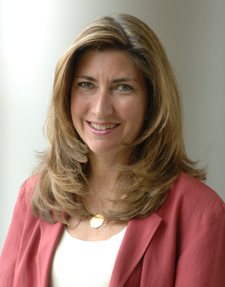 |
Maria Joyce, new CFO for the Clinical Center
|
Maria Joyce in June became the Clinical Center’s new Chief Financial Officer (CFO). Joyce replaces former CC CFO Lisa Lacasse, who left the position in November for the American Cancer Society.
Joyce is a CPA in the state of Maryland and holds a master’s in business administration from Johns Hopkins University and an undergraduate degree from Shepherd University. She has worked for HHS for several years.
Before coming to the CC, she was the director of the Division of Financial Operations at the Program Support Center within the Office of the Secretary, where she was responsible for accounting operations, financial reporting, financial systems, debt management, and travel management. She also served as the director of NIH’s Office of Business Systems and Finance in the Office of Research Services (ORS), where she was the CFO and CIO for ORS and the Office of Research Facilities.
Her federal government tenure also includes time at the Federal Deposit Insurance Corporation, where she worked in accounting policy, internal auditing, and enterprise financial systems development. She spent 10 years in the private sector, at MCI and Marriott’s corporate headquarters, performing accounting, finance, and project management functions.
Since 2003 Joyce has been a member of the NIH Federal Credit Union’s Board of Directors, where she is also the treasurer. She is also a member of the credit union’s assets and liabilities management committee and the information technology committee.
Her awards include a 2004 NIH award for design and implementation of a best practices approach for lease planning and analysis, a 2003 GSA achievement award for real property innovation and honorable mention for best innovative practice, a 2003 NIH award for outstanding financial leadership responding to security needs, and a 2003 NIH award for organizational “delayering.”
As CFO, Joyce is responsible for maintaining the hospital’s fiscal integrity by serving as the principal advisor to the CC Director Dr. John I. Gallin and other senior staff for the financial management of planning, formulation, execution, and evaluation of programs.
Back to Top
New chief leads Rehabilitation Medicine’s Physical Therapy Section
 |
Dr. Jerome Danoff, new chief of the Physical Therapy Section within the CC Rehabilitation Medicine Department
|
At the end of May Dr. Jerome Danoff became chief of the Physical Therapy Section within the Clinical Center Rehabilitation Medicine Department (RMD). Danoff replaces Charles McGarvey, who retired in February 2007.
Danoff holds a PhD in kinesiology from the University of Maryland, a Master of Science in aerospace engineering from Pennsylvania State University, a Bachelor of Engineering Science from Johns Hopkins University, and a physical therapy degree from the University of Maryland.
He has taught in the areas of anatomy, physiology, kinesiology, biomechanics, modalities, statistics, and research design for more than 20 years and served on the faculties of the University of Maryland, George Washington University, and Howard University, where he was chair of the Physical Therapy Department. He was also an adjunct faculty member at Boston and Shenandoah Universities.
In addition to teaching, Danoff has been actively involved in research and has served as a research consultant to the Department of Rehabilitation Medicine since 1984. His research interests include normal and abnormal movement analysis; cancer treatment outcomes, modalities; HIV/AIDS functional capabilities in infants, children, and adolescents; functional assessment and performance issues for stroke and cardiac problems; and acupuncture. He has authored or co-authored more than 40 peer-reviewed publications.
An avid fitness enthusiast, Danoff commutes by bicycle, holds a black belt in karate, taught self-defense classes, and completed several marathons, triathlons, and 24-hour relays. His other hobby is playing trumpet in the NIH Community Orchestra, several smaller groups, and in various musicals around the region.
Danoff is a member of the American College of Sports Medicine and the American Physical Therapy Association (APTA). He is a licensed physical therapist and is active in the Orthopedic, Clinical Electrophysiology, and Research Sections of the APTA. He also is a manuscript reviewer for several professional journals.
As chief of the Physical Therapy Section, Danoff will direct the clinical operations of physical therapy staff and support PT section research initiatives, as well as wider CC research support. He will also be part of the coordination of Department research activities with other chiefs in RMD.
CC RMD Chief Dr. Leighton Chan called Danoff “a superb researcher, administrator, and clinician. We are very lucky to have him join our staff full time.” Danoff said he is “excited to be joining this outstanding staff of clinicians and scientists. We will be working together to support the NIH mission of medical research and superior patient care.”
Back to Top
A round-up of recent retirements around the Clinical Center
Editor’s note: Due to the large number of retirees, CC News plans several round-ups throughout the year with short profiles and portraits of recent retirees.
Photo and text submissions are welcome for this regular feature.
Lillian Butler, nursing consultant for DCRI, retired Feb. 1 after nearly 35 years of service.
Butler began working at NIH in 1973 as a mental health nurse assisting clinical trials of mood disorders. In 1989, she began working in the Information Systems Department as a nurse informatics consultant. Her work involved coding for protocol screen development, user support, teaching the Medical Information System (MIS) to care providers, and troubleshooting system problems. She also worked closely with the Pharmacy Department to code and design screens for medication orders.
Since participating in the conversion of MIS to CRIS in 2004, Butler’s work focused on user support by teaching CRIS users, staffing the support center, and acting as lead IT nurse consultant for “Walking Wednesday” CRIS rounds.
In retirement Butler will spend more time with her daughters Samantha, Shannon, and Laura, as well as her six grandchildren. She plays alto domra, a three-stringed Russian instrument, in the Washington Balalaika Orchestra, as well as bluegrass mandolin. She also enjoys outdoor sports, including ballroom and swing dancing, ice skating, and swimming.
Barbara Corey, nurse manager for OP8, OP11, the 12W Vaccine Research Center, the 5NEN cardiology testing unit, and the B2 radiation oncology unit, retired May 23 with 25 years at CC.
Corey came to NIH as a clinical nurse on the 2E surgical oncology unit in 1982. Three years later she became the 13E medical oncology unit head nurse, a position she would hold for 10 years. From 1995-2005 Corey served as nurse manager of 13W pediatric oncology, the OP13 pediatric clinic, and the 9W pediatric unit. “Each assignment at the Clinical Center was exciting and memorable because of all of the staff I worked with,” Corey said.
A Baltimore native, Corey holds a Master of Science in nursing from George Mason University and was a member of the first RN to Bachelor of Science in nursing class at the University of Central Florida.
Before she began her NIH career, she worked at Johns Hopkins University Hospital, Nashoba Hospital, St. Mary’s Hospital, and Winter Park and Orlando General Hospitals. She also spent two years in Bangkok, Thailand, while her husband was stationed there and her children were infants.
In retirement, Corey is looking forward to spending more time with her husband Jim, sons Matt and Doug, and two puppies in their new home in Harpers Ferry, W. Va.
Dee Koziol, clinical epidemiologist with the Biostatistics and Clinical Epidemiology Service, retired on April 3 with 36 years of service.
Koziol came to the CC in 1972 as a medical technologist with the Department of Laboratory Medicine’s Clinical Chemistry Service. She next spent 10 years in the Department of Transfusion Medicine doing viral hepatitis research, and then spent 16 years with the Hospital Epidemiology Service. There she first worked as an infection control specialist and then served for several years as deputy hospital epidemiologist. She transferred to Biostatistics when the service was created in 1999.
Koziol earned her MPH and PhD degrees from the Johns Hopkins University School of Hygiene and Public Health while working full-time at NIH. “It has been a fantastic place to work and my supervisors and the CC directors have been very supportive in allowing me to grow in experience and education. Without their encouragement and support I would not have been able to obtain my graduate degrees, expand my knowledge, and advance into new fields of study,” she said.
Koziol’s retirement plans include part-time work, travel, gardening, and reading.
Andrea Rander, director of volunteer services and language interpreters programs within the CC Social Work Department (SWD), retired on June 30.
In her first and only position at NIH since 1990 as the leader of both programs, Rander did the behind-the-scenes work to make sure that volunteers and interpreters were there to assist CC patients whenever they needed them.
Rander earned her undergraduate degree in family and community development from the University of Maryland. She received her certification as a trainer of trainers for language interpreters in 1997 from the Hospital Cultural Interpreter Network in Toronto, Canada, and is an American Hospital Association certified administrator of volunteer services. While at NIH she served on several committees, including those for Take Your Child to Work Day, pastoral education, day care, and the Friends of the Clinical Center Board. She was the president of the Volunteer Services Directors Division for the Healthcare Council of the National Capital Area chapter and chair of the communications committee for the American Society of Directors of Volunteer Services.
She received CC Director’s Awards in 1999, 2006, and 2007 for her work with the volunteer program, a SWD training curriculum, and the language interpreter program, whose members also presented her with an award of excellence in 2004. She also received an NIH Director’s Award assisting the move into the new hospital.
In retirement, Rander plans to spend more time with her four grandchildren, enroll in creative writing and photography classes, travel, and of course volunteer in several capacities—including tutoring adults in reading and teaching high school students at her church.
Stephanie Turner, administrative officer for the Nuclear Medicine Department, retired on Dec. 31 after 23 years at NIH
and 20 years with the CC.
Turner came to NIH in 1984 as an NLM library technician. After three years in that role, she moved to the CC to work with the Hospital Administrative Office, where she assisted with the renovation and refurbishing of patient units.
Before the creation of the Edmond J. Safra Family Lodge, the CC hosted selected patients and families in a guest house of eight off-site apartments. Working with the Office of Facility Management, Turner outfitted the apartments with furniture, phone service, and housekeeping and handled the maintenance issues for the units until they were closed when the lodge opened to guests. She served for almost 10 years as a member of Family Lodge Committee, which planned the construction and operation of the guest facility.
Turner also served as co-founder, instructor, and secretary/treasurer of the NIH Judo Club from 1979 to the present; CC representative to the NIH R&W Executive Council from 1989 to 2007; treasurer of the now defunct NIH Garden Club from 1999 to 2002; and held several positions with the NIH Sailing Association from 1985 to the present.
In 2008 Turner finished her horticulture certificate from the USDA graduate school and began training as a master gardener with the University of Maryland’s extension service, whose mission is to dispense gardening advice to Montgomery County residents. The garden around her home in Silver Spring was featured in the November/December 2007 issue of Washington Gardener magazine.
Back to Top
Healing waters fountain now in courtyard
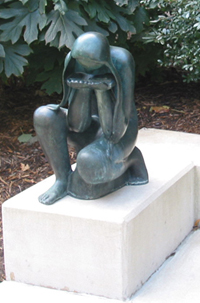 |
The Healing Waters fountain is now located in the west courtyard.
|
The fountain and statue Healing Waters, created by Azriel Awret and purchased by NIH in 1987, has been moved to the courtyard to the west of the Atrium. Its previous locations were the Lipsett Auditorum waiting area by the shark tank and at the base of the escalator between the first and second floors.
This bronze sculpture of a young woman drinking water from her cupped hands echoes the Biblical reference of drinking from the healing waters of Bethesda. In Aramaic, “beth hesda” means “house of mercy.”
According to tradition, an angel moved the waters and healed the sick at the Pool of Bethesda in Jerusalem. As recorded in John 5:1-9, it was at the Pool of Bethesda that Jesus healed a lame man.
Artists Azriel and Irene Awret met at Belgium’s Mechelen Nazi transit camp. They married in 1944 and in the 1970s moved to Falls Church, Va. Their art includes murals at Montgomery County schools, Azriel’s sculptures at George Mason University and Strathmore, and Irene’s book, “They’ll Have to Catch Me First,” about her experience as a Holocaust survivor.
Azriel’s second work on the NIH campus is on the grounds of the Children’s Inn.
Back to Top
Team NIH at Komen Race for the Cure
 |
(from left): Team NIH members Stephen Hall, Lauren Stringi, Connie Kotefka, Pat Piringer, Jacqueline Stephens, Maureen Gormley, and Jim Kinkead
|
About 40 NIH colleagues participated as Team NIH at the 2008 Komen National Race for the Cure to fight breast cancer on June 7.
Despite the heat and humidity, Team NIH was the first team to cross the finish line.
In 2009, Clinical Center staff will advertise the event earlier and offer registration on-site to make the event more readily accessible to NIH’ers.
Back to Top
News Briefs
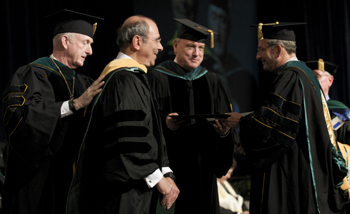 |
CC Director Dr. John I. Gallin receives his Mastership hood from 2007-2008 American College of Physicians (ACP) President Dr. David C. Dale during the ACP Convocation Ceremony in Washington, D.C., on May 15. ACP Executive Vice President and CEO Dr. John Tooker looks on while 2007-2008 ACP Chair of the Board of Regents DR. Joel S. Levine prepares to hand Gallin his Mastership certificate.
|
CC Director inducted as Master in the American College of Physicians
Clinical Center Director Dr. John I. Gallin was inducted as a Master in the American College of Physicians (ACP) in May in Washington, D.C. Masters comprise a small group of highly distinguished physicians who are selected from among ACP Fellows. Election by the Board of Regents is based on preeminence in medical practice or research. In addition, the ACP awarded Dr. Robert M. Chanock, a senior investigator with NIAID, the American College of Physicians Award for outstanding work in medical science.
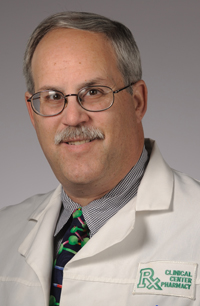 |
Dr. Barry Goldspiel
|
Goldspiel new deputy pharmacy chief
Dr. Barry Goldspiel has been named the deputy chief of the CC Pharmacy Department. He came to the CC in 1987 as a clinical pharmacy specialist for oncology. He later became the special projects pharmacist while continuing in a clinical and teaching role. In that capacity, Dr. Goldspiel was involved with the medication component of the MIS to CRIS conversion and the move to the CRC. Robert DeChristoforo, chief of the Pharmacy Department, said Goldspiel has been “an invaluable resource” in the implementation of Sunrise Medication Manager, the Pharmacy Department’s new inpatient information system.
Article by CC staffer awarded Clarion
An article titled "The Cancer Survivor's Prescription for Living" that appeared in the April 2007 issue of the American Journal of Nursing was selected as a Clarion award winner by the Association for Women in Communications. Sandra Mitchell, an oncology nurse practitioner with the Chronic GVHD Clinic and Study Group and predoctoral fellow at the CC Nursing Research and Practice Development, Nursing and Patient Care Services, was one of the article co-authors. The award, which was given in the category of "Magazine series, special section or group project, external publication," considered pieces across all subject matters, not just health care. Started in 1972, the Clarion awards are named for the medieval trumpet known for its clarity and symbolize excellence in clear, concise, communications.
2008 leadership brown bag series
The Office of Organizational Development's second brown bag series in 2008 will share proven strategies that will enhance CC leaders' ability to achieve positive outcomes, move the organization forward, and strengthen their repertoire of skills. All sessions occur from noon to 1pm in 4-2551 except the Oct. 29 event, which will take place in 2C116. Space is limited. Please RSVP to Yasmin Coates at ycoates@cc.nih.gov or 301-402-5285.
-
July 17: "To meet or not to meet: running effective meetings"—Antoinette Jones;
-
Sept. 10: "Learning to lead by example: creating a productive atmosphere in the workplace"—Maureen Gormley;
-
Oct. 29: "Strengthening your performance management"—Robin Wink;
-
Nov. 19: "Coaching lessons: they make a difference"—Panel of peers who have received coaching; and
-
Dec. 3: "Diversity: deepening understanding"—Denise Ford.
NIH Darwin Day call for art entries
 |
An example of a photograph taken at the Galapagos Islands.
|
February 12, 2009, marks the 200th birthday of Charles Darwin and the 150th year since his seminal work, “On the Origin of Species,” was published. To recognize Darwin’s scientific accomplishments, including his observations on plant and animal life, NIH is planning a variety of activities, such as a lecture series, film screenings, and theater performances. From November 2008 through February 2009, the Clinical Center’s artistic gallery spaces will display photographs of the Galapagos Islands, where Darwin visited. NIH employees and patients, as well as photographers from the community, may submit their photos for consideration by August 29. Artists will be notified within three weeks if their work is selected. Contact Crystal Parmele or Lillian Fitzgerald at 301-402-0115 with questions or submissions.
Sickle cell disease and vasculopathy
A workshop on vasculopathy in sickle cell disease will be held August 27-28, 2008, at the Natcher Conference Center. For more information, please visit www.sicklecellmeeting. net or contact Sue Dilli at sue@strategicresults.com or 443-451-7252.
Mitochondrial biology, cardiovascular health conference
The Mitochondrial Biology in Cardiovascular Health and Diseases Conference will be held Oct. 6-7, 2008 in the Natcher Conference Center. For more information, please visit www.mitochondrial2008.com or contact Jennifer Barry at jennifer@strategicresults.com or 443-451-7254.
Back to Top
New clinical research protocols
The following new clinical research protocols were approved in May:
A Phase II Trial of Peginterferon Alpha-2b (Pegintron) for Neurofibromatosis Type 1 Related Unresectable, Symptomatic or Life-Threatining Plexiform Neurofibromas, 08-C-0130, Brigitte C. Widemann, MD, NCI
A Pilot Study of Imatinib Mesylate in Children and Adults with Sclerotic Skin Changes of Chronic Graft-Versus-Host Disease, 08-C-0148, Edward W. Cowen, MD, NCI
Response and Adaptation to Aerobic Exercise in Patients with Pulmonary Hypertension: Initial Studies for Establishing Guidelines, 08-CC-0133, Leighton Chan, MD, CC
Preventing Excessive Weight Gain in Adolescent Girls at High-Risk for Adult Obesity, 08-CH-0139, Jack A. Yanovski, MD, NICHD
Pilot Study of Sunitinib Malate for Advanced Ocular Disease of Von Hippel-Lindau Syndrome, 08-EI-0129, Catherine Meyerle, MD, NEI
Pilot Study of Intravitreal Injection of Ranibizumab for Macular Telangiectasia with Neovascularization (MACTEL 1), 08-EI-0146, Wai T. Wong, MD, NEI
Pilot Study of Intravitreal Injection of Ranibizumab for Macular Telangiectasia without Neovascularization (MACTEL 2), 08-EI-0147, Wai T. Wong, MD, NEI
Pilot Study of Tolerability of Lithium Therapy in Patients with Spinocerebellar Ataxia Type I (SCA1), 08-N-0134, Grisel J. Lopez, MD, NINDS
Evaluation and Diagnosis of Potential Research Subjects with Pain and Fatigue Syndromes, 08-NR-0132, Leorey N. Saligan, CRNP, NINR
Back to Top
This page last updated on 12/14/2017


 The information on this page is archived and provided for reference purposes only.
The information on this page is archived and provided for reference purposes only.